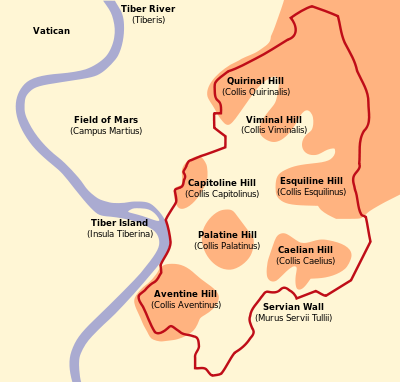
The Seven Hills of Rome (Italian: Sette colli di Roma [ˌsɛt̪ːe ˌkɔlːi d̪i ˈroːmä], Latin: Septem montes Romae) east of the river Tiber form the geographical heart of Rome, within the walls of the ancient city.
The seven hills are:[1]
- Aventine Hill (Latin, Aventinus; Italian, Aventino)
- Caelian Hill (Caelius, Celio)
- Capitoline Hill (Capitolinus, Campidoglio)
- Esquiline Hill (Esquilinus, Esquilino)
- Palatine Hill (Palatinus, Palatino)
- Quirinal Hill (Quirinalis, Quirinale)
- Viminal Hill (Viminalis, Viminale)
| History |
When Constantinople was built later, it also claimed that the city is also on the seven hills, following Rome. See Seven hills of Istanbul.
References
1. Heiken, Grant; Funiciello, Renato; de Rita, Donatella (Oct 24, 2013). "Chapter 11: Field Trips in and Around Rome". The Seven Hills of Rome: A Geological Tour of the Eternal City. Princeton University Press. p. 174. ISBN 9780691130385.
No comments:
Post a Comment